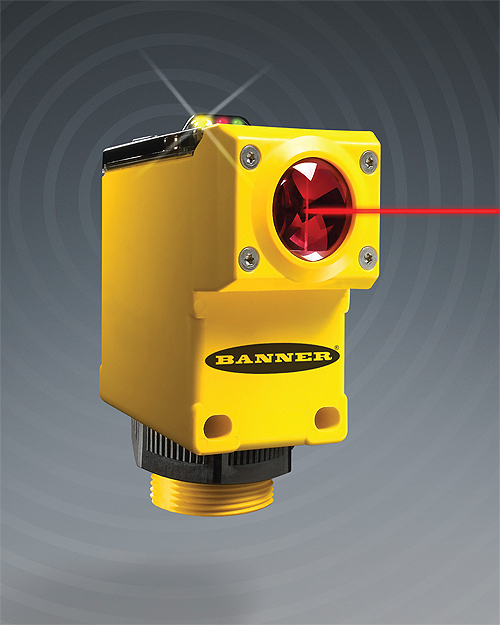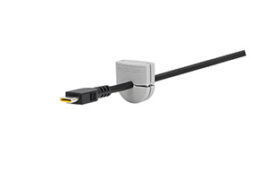by Bob Gardner, Senior Product Manager, Banner Engineering
Today’s wireless I/O stations are essentially small remote I/O stations with a wireless backbone. Newer capabilities solve the battery and power issues of earlier generations of wireless networks. Here are tips on when and how to use the latest wireless technology.
Wireless networks provide remote monitoring and supervisory control, allowing manufacturers to increase overall process efficiency and productivity. By eliminating the wire limitations experienced with conventional systems, wireless networking systems improve data logging, process monitoring and control, while maintaining high levels of security and integrity.

A wireless sensor in conjunction with a tower light can increase production line efficiency by immediately notifying technicians of progress.
Before using wireless, consider:
Wireless technology has limitations, but like any technology, it is powerful when properly applied. Here are a few factors to consider before implementing wireless devices:
- Is there remote power available? Wireless signals require little power, allowing remote locations to be monitored where there is no power. However, the sensor used in these applications must also run on low power. Today, technology can sense many things with low power, including temperature, pressure, dry contacts, inductive and photoelectric proximity sensors. All of these sensors can operate for years on inexpensive AA batteries. If another source of power is used remotely (line or solar), any type of sensor can be used.
- How fast do you need a response? This issue is tightly coupled with the power issue. If there is power available, the sensor and wireless transmitter can always be “on.” This allows for real-time control and less than one second response times. If power is not available, it is important to balance the desired response time with the available battery life. For example, if you measure and report the temperature of a remote location at one-minute intervals, you might have a one-year battery life. Alternatively, if you slow down to 15-minute intervals, you might have a 10-year battery life. Faster is not always better when using battery-powered operation.
- What kind of wireless range do you need? Wireless systems exist that can transmit many miles of “Line of Sight,” or across an entire large factory. Selecting a long-range system will simplify the design by eliminating repeaters. It will also provide flexibility for adding additional nodes in the future.
What happens when a wireless link is lost? While properly designed wireless systems are reliable, it is crucial to consider what happens when a link goes down; the system should fail gracefully. For first time wireless users, it is best to start with a non-mission critical task. If the link is lost, the outputs should automatically go to a predefined state.
When to go wireless
Consider using wireless when it provides a cost-efficient, reliable alternative to other network approaches. Wireless is suitable for applications that:
- Have slow response time needs of 0.5 second to many minutes (consider battery life trade off as well)
- The cost of wiring is expensive
Wireless technology is an ideal option when the cost of wiring becomes prohibitive in applications. This happens when there are:
- Long or multiple wire runs, for example, of more than 50 feet
- Slip rings or cable tracks
- Wire runs need to go through floors or walls
- End points are in motion or can be reconfigured frequently
Applications with the above factors include: call for parts, monitoring or displaying machine or line status, rotary or mobile text fixtures, and networking with AGVs.
Wireless technology advances with wireless sensors
Today’s wireless networking technology consists of a dependable wireless I/O system, and often a unique wireless photoelectric sensor.
For performance, newer wireless networking technologies feature:
- Extremely low power
- Bidirectional data transmission: Every end point can send and receive data. One-way communication systems offer limited control and cannot be acknowledged, which has a significant impact for industrial controls
- Real time: If the target is a five year battery life and real time response, the system should respond typically within 125 ms. Higher speed requires more power and decreases battery life
- Extended range
- Site survey: This feature provides a way to accurately test wireless signal strength
- Multiple sensor support: For optimal performance, each wireless gateway should support many sensors
Wireless I/O
Today’s wireless I/O stations are essentially small remote I/O stations with a wireless backbone, available with standard digital, analog and temperature inputs and outputs. This type of system replaced PLC I/O cards and the PLC I/O network.
In the PLC world, sensors are always connected to power, but often an I/O node requires battery power. To ensure reduced power and extended battery life, a concept called “switched power supply” is used. Each battery-powered I/O node has one or more power supply terminals that provide 5 to 24 volts for a short time—this is done using a voltage pump and power from the battery. The power can be switched on to power a sensor. Once the sensor is on and operating, its output is read. Then, the sensor is turned off. By switching the sensor on and off, the sensor can spend most of the time off. This can increase the battery life by 100 times or more. However, the trade off is response time. Understandably, the sensor cannot sense when it is off.
Using the switched power supply method, the wireless photoelectric sensor can operate on two replaceable AA Lithium batteries for up to five years, depending on the application. This type of wireless sensor uses an average power of 100 to 200 microwatts, producing 1,000 times less power than a 24-volt wired sensor with similar performance.
In addition to extended battery life, the wireless I/O system makes it quick and easy to connect a variety of I/O types wirelessly to a PLC. Its range exceeds WiFi with a real time response rate at 125 ms. The data traffic is fully acknowledged and is reliable and deterministic. It is also noise immune and does not interfere with existing wireless systems.
Self-contained, “Peel And Stick” sensors
Using this knowledge and technology, a new generation of wireless was created: the wireless photoelectric sensor. Combining photoelectric sensing and wireless technology into a single housing, this completely, self-contained system works out of the box, operating entirely on battery power.

Self-contained, “peel and stick” sensors include a battery, radio and sensor, all in a single housing.
With no configuration software required for setup, the wireless sensor is easy to install. Operators simply bind (or pair) a wireless sensor with a wireless gateway. Then, the sensors output appears at the gateway output terminal. The sensor provides up to 3,000 ft/1 km line-of-sight sensing distance to its paired gateway. By eliminating the need to wire sensors, operators can easily add a single photoelectric sensor in minutes, creating a scalable, wireless sensor network infrastructure to monitor environments. Users can now apply sensing technology in situations where it was not previously possible—all while reducing installation and maintenance costs.
For flexible performance, there are multiple photoelectric sensing modes supported including retroreflective, convergent and fiber. Additionally, a model is available that takes in dry contacts, for example from a push button, or works with inductive proximity sensors. There are also two gateway models available: two out and six out with Modbus RTU. The two out model is suitable for entry-level single wireless links. One output indicates the state of the sensor, while the second output provides a fault signal if there is a problem. The six out model with RTU can connect up to 47 sensors. The status of the sensors is reported to the PLC using a Modbus interface. If an application requires more than 47 sensors, multiple gateways can co-exist in the same physical area without interfering with each other. For future growth, the system can support analog and digital data, removing the limits to the types of sensors that can be made wireless.
Applying wireless sensors
Wireless sensor technology can be used for a variety of applications, including notification or call for service applications. For example, a wireless sensor in conjunction with a tower light can increase production line efficiency by immediately notifying technicians.
Each production area has one switch box and one tower light connected to the input on a wireless sensor with dry contact inputs. When a manager or technician is needed on the production line, an employee flips a switch. A tower light installed near the manager’s is connected to the gateway’s outputs. The tower light indicates which production line needs a manager’s attention. At the same time, the tower light installed at that production line also lights up. Using this notification system enhances production efficiency by reducing the need to constantly check each production line.
Another unique application example is using wireless sensing to call for parts. Production operators require an easy way to call the forklift drivers to deliver additional parts or to remove completed assemblies from a workstation. Because the production area is frequently reconfigured when requirements change, a wired system would require time-consuming rewiring with every reconfiguration.

Using wireless sensors and indicator lights eliminates complex cable installation and provides easy rearrangement capabilities if the plant layout changes.
Using wireless sensors and indicator lights eliminates complex cable installation and eases rearrangement if the plant layout changes. Each production operator is equipped with a toggle switch and a wireless sensor with a dry contact input. The gateway is connected to large lane status display board with multiple indicator lights. When a production operator needs supplies, the operator toggles the switch connected to the wireless sensor, which results in the corresponding indicator light on the display board to light up—indicating an operator needs parts. After the parts are delivered, the operator toggles his switch again, turning the light off. This allows users to increase productivity with real-time parts status of all their production lines.

Wireless sensors can be used with traditional magnetic reed switches to reliably monitor doors and windows to ensure a safe and secure facility.
Wireless sensors can also be used with traditional magnetic reed switches to reliably monitor doors and windows to ensure a safe and secure facility. Magnetic switches are connected to wireless sensors, which transmit switch status information back to a central location. This helps security personnel monitor the opening of exits that should remain closed during normal operation.
Banner Engineering
www.bannerengineering.com
Filed Under: I/O modules, CONNECTIVITY • fieldbuses • networks, Slip rings + rotary unions, Wireless • 5G and more, SENSORS, PLCs + PACs





Tell Us What You Think!